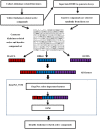Alzheimer-Compound Identification Based on Data Fusion and forgeNet_SVM
- PMID: 35959292
- PMCID: PMC9357977
- DOI: 10.3389/fnagi.2022.931729
Alzheimer-Compound Identification Based on Data Fusion and forgeNet_SVM
Erratum in
-
Corrigendum: Alzheimer-compound identification based on data fusion and forgeNet_SVM.Front Aging Neurosci. 2023 Nov 17;15:1322944. doi: 10.3389/fnagi.2023.1322944. eCollection 2023. Front Aging Neurosci. 2023. PMID: 38046467 Free PMC article.
Abstract
Rapid screening and identification of potential candidate compounds are very important to understand the mechanism of drugs for the treatment of Alzheimer's disease (AD) and greatly promote the development of new drugs. In order to greatly improve the success rate of screening and reduce the cost and workload of research and development, this study proposes a novel Alzheimer-related compound identification algorithm namely forgeNet_SVM. First, Alzheimer related and unrelated compounds are collected using the data mining method from the literature databases. Three molecular descriptors (ECFP6, MACCS, and RDKit) are utilized to obtain the feature sets of compounds, which are fused into the all_feature set. The all_feature set is input to forgeNet_SVM, in which forgeNet is utilized to provide the importance of each feature and select the important features for feature extraction. The selected features are input to support vector machines (SVM) algorithm to identify the new compounds in Traditional Chinese Medicine (TCM) prescription. The experiment results show that the selected feature set performs better than the all_feature set and three single feature sets (ECFP6, MACCS, and RDKit). The performances of TPR, FPR, Precision, Specificity, F1, and AUC reveal that forgeNet_SVM could identify more accurately Alzheimer-related compounds than other classical classifiers.
Keywords: Alzheimer; data fusion; feature selection; machine learning; network pharmacology; virtual screening.
Copyright © 2022 Yang, Bao and Hong.
Conflict of interest statement
The authors declare that the research was conducted in the absence of any commercial or financial relationships that could be construed as a potential conflict of interest.
Figures





Similar articles
-
Disease-Ligand Identification Based on Flexible Neural Tree.Front Microbiol. 2022 Jun 6;13:912145. doi: 10.3389/fmicb.2022.912145. eCollection 2022. Front Microbiol. 2022. PMID: 35733966 Free PMC article.
-
Identify Diabetes-related Targets based on ForgeNet_GPC.Curr Comput Aided Drug Des. 2024;20(7):1042-1054. doi: 10.2174/0115734099258183230929173855. Curr Comput Aided Drug Des. 2024. PMID: 38173214
-
Corrigendum: Alzheimer-compound identification based on data fusion and forgeNet_SVM.Front Aging Neurosci. 2023 Nov 17;15:1322944. doi: 10.3389/fnagi.2023.1322944. eCollection 2023. Front Aging Neurosci. 2023. PMID: 38046467 Free PMC article.
-
COVID-19 diagnosis: A comprehensive review of pre-trained deep learning models based on feature extraction algorithm.Results Eng. 2023 Jun;18:101020. doi: 10.1016/j.rineng.2023.101020. Epub 2023 Mar 16. Results Eng. 2023. PMID: 36945336 Free PMC article. Review.
-
A review on machine learning approaches and trends in drug discovery.Comput Struct Biotechnol J. 2021 Aug 12;19:4538-4558. doi: 10.1016/j.csbj.2021.08.011. eCollection 2021. Comput Struct Biotechnol J. 2021. PMID: 34471498 Free PMC article. Review.
Cited by
-
The integration of machine learning into traditional Chinese medicine.J Pharm Anal. 2025 Aug;15(8):101157. doi: 10.1016/j.jpha.2024.101157. Epub 2024 Dec 4. J Pharm Anal. 2025. PMID: 40823261 Free PMC article. Review.
-
Machine learning in TCM with natural products and molecules: current status and future perspectives.Chin Med. 2023 Apr 20;18(1):43. doi: 10.1186/s13020-023-00741-9. Chin Med. 2023. PMID: 37076902 Free PMC article. Review.
-
Multi-level association rule mining and network pharmacology to identify the polypharmacological effects of herbal materials and compounds in traditional medicine.Brief Bioinform. 2025 Jul 2;26(4):bbaf328. doi: 10.1093/bib/bbaf328. Brief Bioinform. 2025. PMID: 40622480 Free PMC article.
References
LinkOut - more resources
Full Text Sources

